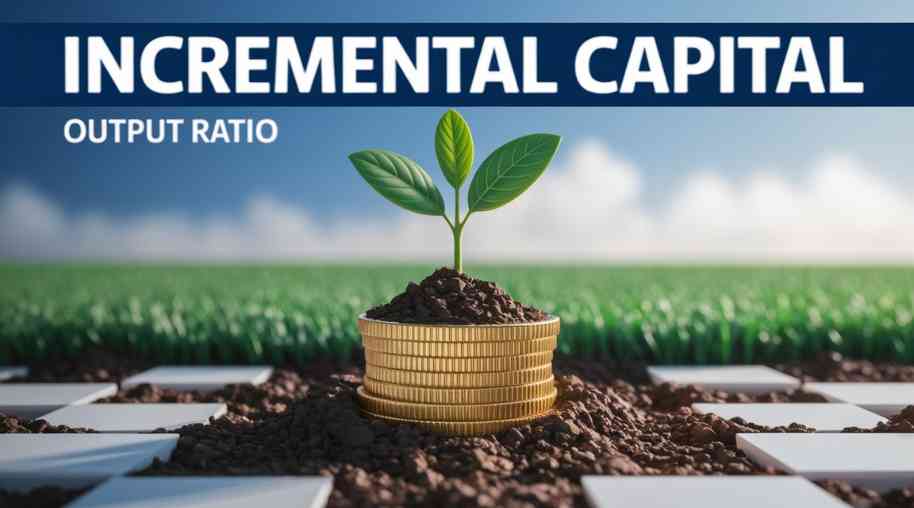ICOR Full Form-Incremental Capital Output Ratio
by Shashi Gaherwar
0 2205
Understanding Incremental Capital Output Ratio (ICOR) and Its Economic Impact
Economic growth and development depend largely on how efficiently **capital** is utilized to generate **output**. One of the key indicators of economic efficiency is the **Incremental Capital Output Ratio (ICOR)**. This metric helps **policymakers**, **investors**, and **economists** assess the effectiveness of capital investment in driving economic output. This article explores the concept, formula, significance, factors affecting ICOR, advantages, limitations, and its role in **economic policymaking**.

What is the Incremental Capital Output Ratio (ICOR)?
The **Incremental Capital Output Ratio (ICOR)** measures the **additional capital** required to generate **one additional unit of output** in an economy. It is used to evaluate the **efficiency of capital investment** in producing economic growth. A **lower ICOR** indicates **higher efficiency**, meaning less capital is required to generate growth, while a **higher ICOR** suggests **inefficiencies** in capital allocation and utilization.
Formula for ICOR
The ICOR is calculated using the following formula:
ICOR = Investment (I) / Change in Output (ΔY)
Where:
- Investment (I): Refers to the **capital invested** in an economy.
- Change in Output (ΔY): Refers to the **increase in Gross Domestic Product (GDP)** or economic output.
Pro Tip: A lower ICOR reflects a more efficient economy, requiring less capital for growth.
Significance of ICOR
ICOR plays a vital role in economic analysis:
- Measures Economic Efficiency: Helps assess how effectively **capital** is being used to drive growth.
- Guides Investment Decisions: Useful for **policymakers** and **businesses** to optimize **resource allocation**.
- Supports Economic Planning: Governments use ICOR to set **investment priorities** and **infrastructure development**.
- Indicates Productivity Trends: A rising ICOR over time signals **declining productivity** and inefficiencies.
Factors Affecting ICOR
Several factors influence the ICOR:
- Technological Advancements: Improved **technology** enhances productivity, reducing ICOR.
- Infrastructure Development: Efficient **infrastructure** leads to better capital utilization.
- Skill and Labor Productivity: A **well-trained workforce** ensures capital investments yield higher output.
- Sectoral Allocation of Investment: Investment in **high-productivity sectors** results in a lower ICOR.
- Government Policies: Policies promoting **ease of doing business** and **industrial efficiency** impact ICOR.
- Economic Stability: A **stable economy** with minimal disruptions reduces inefficiencies in capital utilization.
Advantages of ICOR
ICOR offers several benefits:
- Quantifies Economic Growth Efficiency: Provides a **numerical measure** of capital efficiency.
- Helps in Comparative Analysis: Allows comparison across **economies** and **industries**.
- Supports Policymaking: Governments use ICOR to formulate **economic strategies**.
- Identifies Growth Bottlenecks: Helps in recognizing **inefficiencies** in capital deployment.
- Guides Investment Strategies: Useful for **businesses** and **investors** in capital-intensive sectors.
Limitations of ICOR
Despite its usefulness, ICOR has certain limitations:
- Does Not Account for External Factors: **Economic disruptions**, **inflation**, and **global events** may distort ICOR.
- Ignores Non-Capital Growth Factors: **Labor efficiency**, **technology**, and **innovation** are not directly reflected.
- Applicable Mostly for Long-Term Analysis: **Short-term economic changes** may not be accurately captured.
- Difficulties in Accurate Measurement: **Data discrepancies** and fluctuating **investment patterns** can affect calculations.
ICOR and Economic Policymaking
Governments and financial institutions use ICOR to design **economic policies**, such as:
- Infrastructure Development Plans: Identifying areas needing **capital investment**.
- Sectoral Investment Strategies: Allocating funds to **sectors with lower ICOR** for better returns.
- Technology Promotion Policies: Encouraging **automation** and **innovation** to improve capital efficiency.
- Monetary and Fiscal Policies: Adjusting **interest rates** and **taxation** to optimize investment levels.
The **Incremental Capital Output Ratio (ICOR)** is a crucial metric for understanding **economic efficiency** and guiding **investment decisions**. A lower ICOR signifies a more **productive economy**, while a high ICOR indicates **inefficiencies** in capital utilization. Despite its limitations, ICOR remains an essential tool for **policymakers**, **businesses**, and **economists** in shaping **economic strategies** and driving **sustainable growth**. By focusing on **technological advancements**, **skilled labor**, and **effective policy-making**, nations can lower their ICOR and enhance **economic productivity** for long-term development.
Further Learning Resources
If you’re passionate about building a successful blogging website, check out this helpful guide at Coding Tag – How to Start a Successful Blog. It offers practical steps and expert tips to kickstart your blogging journey!
For dedicated UPSC exam preparation, we highly recommend visiting www.iasmania.com. It offers well-structured resources, current affairs, and subject-wise notes tailored specifically for aspirants. Start your journey today!

Share:








Comments
Waiting for your comments